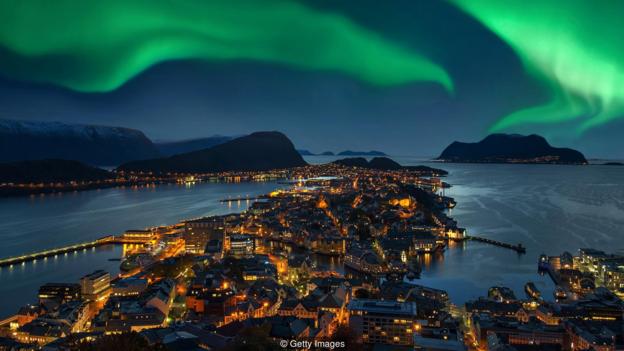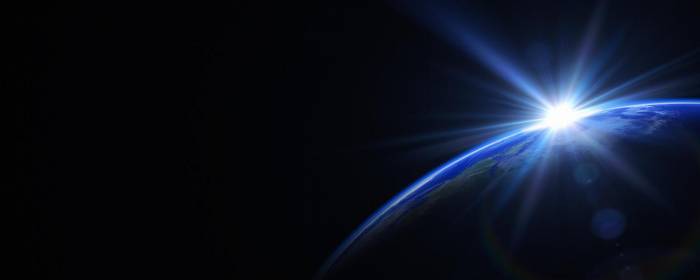As more entrepreneurs dabble in space flight – like SpaceX CEO Elon Musk, who just launched his new Heavy rocket in Florida – they’ll find they have to contend with these kinds of bizarre phenomena.
One of the oddest of all is the one witnessed by Virts. This is the South Atlantic Anomaly (SAA), which combines a massive flash of light without any sound. But the SAA isn’t just a strange sight. It wreaks havoc on computers in the vicinity and exposes nearby humans to higher radiation levels – something that has earned it its nickname ‘the Bermuda Triangle of space’.
As manned space flights become more common and astronauts become more reliant on computers, the challenges SAA poses could become only acuter.

Satellites - and even the ISS - have to spend as little time as possible in this disruptive zone (Credit: Getty Images)
To understand the SAA, you must first understand the Van Allen radiation belts. These are two doughnut-shaped areas of charged particles that surround the Earth and are held in place by its magnetic field. “The Sun puts out a huge amount of radiation,” says Virts, “and a lot of it is particles like electrons shot off the Sun’s surface… All of this material gets shot out in space and the Sun’s magnetic field can bend it. When it gets to Earth, it gets trapped in our magnetic field and forms these radiation belts out in space.”
The good news is that the Van Allen belts protect the Earth from these highly charged electronic particles thrown from the Sun. The bad news is that there’s a catch.
The Earth is not completely round; it bulges slightly in the middle. The Earth’s magnetic poles also aren’t completely in line with its geographical poles, and so it is tilted, resulting in the Van Allen belts also being tilted. The SAA is where the inner Van Allen radiation belt is at its lowest altitude and so at its closest point to the Earth. Due to the tilt, the magnetic field is strongest in the North, leaving an area above the South Atlantic and Brazil right in the path of the Van Allen belt.
It’s not dangerous to the Earth. But it causes havoc to any satellites and other spacecraft such the International Space Station (ISS) that pass through the area, as well as to the people on board – something Virts knows all too well from both his 2010 flight and his time aboard the ISS in 2014.
As well as the white flashes that astronauts report seeing, their computers get affected. “We have an acronym for everything at Nasa,” says Virts. “And these are SEU’s – single event upsets. It just means your computer hiccups and it happens fairly often.

Polar lights can look dramatic from earth but are even more impressive from space, says Terry Virts (Credit: Getty Images)
“This is a well-known area where all different types of satellites – not just a space station with people, but normal communication satellites and others – have problems,” he adds. “You want to kind of get through there as fast as you can on the way to the Moon, or wherever you’re going.”
At the moment, the Hubble Space Telescope, for example, cannot take astronomical observations while flying through the region.
So how do spacecraft and their passengers protect themselves from this pummelling of radiation? Water is the best shield, says Virts. On the ISS, the astronauts use a “water wall”. “It’s just a bunch of this big 50lb [23kg] water bags,” he says – though they aren’t wrapped around the astronauts’ sleeping quarters.
The radiation is closely monitored for the duration of space missions. “There are several electronic radiation detectors that just count radiation hits and send the data back to Earth,” says Virts. “We each carry a radiation monitor with us the entire time we’re in space… I kept that in my pocket for my entire mission, on both of my missions. Even when I went outside on my spacewalks, I brought it with me in my space suit.”
This fight between the Earth’s magnetic field and the solar wind also has another surprising effect: the Aurora, or the Northern and Southern Lights. This is caused when the highly charged particles from the sun hit the Earth’s atmosphere, causing a glowing green light display.
On Earth, people travel thousands of miles to see the Aurora. But while on the ISS, Virts had the best view of all. “From space the Northern lights look very different to the Southern lights,” he explains. “The Northern Lights from the Space Station’s point of view were always this thin band off in the distance and the Southern Lights were always this much bigger cloud, much closer to the space station.”
Of his 215 days in space, this sight has stayed with him. “You’re floating and you’re flying through this gigantic green and red dancing cloud,” he says. “There’s nothing like it on Earth.”

As more spacecraft are launched, they will have to be more resilient to the triangle's effect (Credit: Getty Images)
No matter how beautiful the view, as spaceflight becomes more common and missions more distant, spacecraft need to improve their resilience to SAA and its radiation exposure.
“As we go deeper into the Solar System and further away from Earth, we won’t have mission control to help us instantly,” Virts says. “We might have to wait a few minutes because of the speed of light to get a reply. So computers need to be better with artificial intelligence, and so on.
“And the more powerful computer you get, the more susceptible it is to radiation problems.
“That’ll be a really important thing for future space exploration.”
BBC
More about: Bermuda
















































